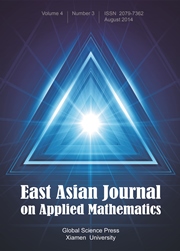Crossref Citations
This article has been cited by the following publications. This list is generated based on data provided by
Crossref.
Wen, You‐Wei
Wang, Man
Cao, Zhiying
Cheng, Xiaoqing
Ching, Wai‐Ki
and
Vassiliadis, Vassilios S.
2015.
Sparse solution of nonnegative least squares problems with applications in the construction of probabilistic Boolean networks.
Numerical Linear Algebra with Applications,
Vol. 22,
Issue. 5,
p.
883.
Chen, Chong
and
Xu, Guoliang
2016.
A new linearized split Bregman iterative algorithm for image reconstruction in sparse-view X-ray computed tomography.
Computers & Mathematics with Applications,
Vol. 71,
Issue. 8,
p.
1537.
He, Hongjin
Ling, Chen
and
Xu, Hong-Kun
2016.
An Implementable Splitting Algorithm for the $$\ell _1$$ ℓ 1 -norm Regularized Split Feasibility Problem.
Journal of Scientific Computing,
Vol. 67,
Issue. 1,
p.
281.
Sun, Min
and
Liu, Jing
2016.
Generalized Peaceman-Rachford splitting method for separable convex programming with applications to image processing.
Journal of Applied Mathematics and Computing,
Vol. 51,
Issue. 1-2,
p.
605.
Chang, Xiaokai
and
Liu, Sanyang
2017.
A 2-block semi-proximal ADMM for solving the H-weighted nearest correlation matrix problem.
Optimization,
Vol. 66,
Issue. 1,
p.
1.
Gao, Yiming
and
Yang, Xiaoping
2018.
TGV-based multiplicative noise removal approach: Models and algorithms.
Journal of Inverse and Ill-posed Problems,
Vol. 26,
Issue. 6,
p.
703.
Wu, Zhongming
Cai, Xingju
and
Han, Deren
2018.
Linearized block-wise alternating direction method of multipliers for multiple-block convex programming.
Journal of Industrial & Management Optimization,
Vol. 14,
Issue. 3,
p.
833.
Zhang, Jian-Jun
Zhang, Jian-Li
and
Ye, Wan-Zhou
2018.
An inexact alternating direction method of multipliers for the solution of linear complementarity problems arising from free boundary problems.
Numerical Algorithms,
Vol. 78,
Issue. 3,
p.
895.
Pang, Jong-Shi
and
Tao, Min
2018.
Decomposition Methods for Computing Directional Stationary Solutions of a Class of Nonsmooth Nonconvex Optimization Problems.
SIAM Journal on Optimization,
Vol. 28,
Issue. 2,
p.
1640.
Wang, Yajun
Wang, Mengmeng
and
Xie, Zhibin
2019.
A PAPR Reduction Method With EVM Constraints for OFDM Systems.
IEEE Access,
Vol. 7,
Issue. ,
p.
171830.
Wang, Wei
Li, Fang
and
Ng, Michael K.
2019.
Structural Similarity-Based Nonlocal Variational Models for Image Restoration.
IEEE Transactions on Image Processing,
Vol. 28,
Issue. 9,
p.
4260.
Liu, Qinghua
Shen, Xinyue
and
Gu, Yuantao
2019.
Linearized ADMM for Nonconvex Nonsmooth Optimization With Convergence Analysis.
IEEE Access,
Vol. 7,
Issue. ,
p.
76131.
Ma, Feng
2020.
Convergence study on the proximal alternating direction method with larger step size.
Numerical Algorithms,
Vol. 85,
Issue. 2,
p.
399.
Tao, Min
2020.
Convergence study of indefinite proximal ADMM with a relaxation factor.
Computational Optimization and Applications,
Vol. 77,
Issue. 1,
p.
91.
Zhao, Qing
Li, Jie
Liu, Shi
Liu, Guoqiang
and
Liu, Jing
2021.
The Sensitivity Optimization Guided Imaging Method for Electrical Capacitance Tomography.
IEEE Transactions on Instrumentation and Measurement,
Vol. 70,
Issue. ,
p.
1.
Yu, Guoyang
Liang, Junli
Fan, Wen
So, Hing Cheung
and
Zhou, Deyun
2022.
Autofocus algorithms with phase error correction for synthetic aperture radar imagery.
Digital Signal Processing,
Vol. 130,
Issue. ,
p.
103692.


